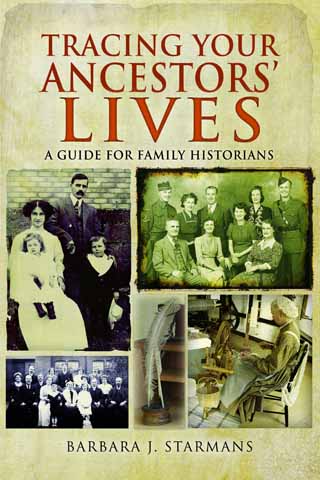Tracing Your Ancestors’ Lives by Barbara J Starmans – Review

By Sandra Callard
Tracing our ancestors has become a popular pastime now that it is relatively easy to track down information about our ancestral families. There are numerous computer sites dedicated to this end, and it has become much easier to construct a complex family tree going back many generations. There are even services that can create a family crest for you, like Crests & Arms.
Now, genealogist Barbara J Starmans has taken things a step further in her book Tracing Your Ancestors’ Lives. It encourages enthusiasts to discover not only who their ancestors are, but also how they lived, what they ate, how they dressed, and generally to ‘get inside their skin and walk in their shoes’.
 This is a revolutionary new approach to the subject, and one not to be taken lightly by beginners of research. Most of us are quite happy to be able to trace our ancestors through a few generations, discovering when they were born, married and died, where they lived and in the course bring to light a few interesting facts about their lives.
This is a revolutionary new approach to the subject, and one not to be taken lightly by beginners of research. Most of us are quite happy to be able to trace our ancestors through a few generations, discovering when they were born, married and died, where they lived and in the course bring to light a few interesting facts about their lives.
“Many available avenues of research”
Starmans’ concept regarding ancestry is to complete all the preliminary facts about our ancestors, and then research the nitty gritty of their lives. This throws up a plethora of detail about them, and it is astounding how many areas of information we can access in this search, most of them completely free and/or online.
For instance, if you know the school your grandmother attended, you can access the school registers and find her name in the attendance book, when she was off sick, the reason why, if she played truant, and generally discover whether she was a diligent pupil or a naughty truant. Fascinating stuff!
She provides real life case studies of subjects such as poverty and wages, life and death, burials, medicine, as well as the prevailing opinions regarding sexual matters and the place of women in society. These can be found in various public papers online, and from private papers and letters which have been donated to societies which support many areas of research. These can be accessed freely through the societies themselves. In many cases the societies have thoughtfully loaded their information online for public access and research.
“A masterly and well-written book”
Starmans’ book is a fascinating read, bringing into the public domain the many available avenues of research that the average researcher may not be aware. The help and information which is out there now is astounding.
It does beg the question as to whether the average amateur ancestry seeker would have the time or the inclination to discover, for example, the type of housing conditions their ancestors lived in, what clothes they wore, and how they got on with their neighbours. Nevertheless, these are things which are now perfectly possible to find out, and which can flesh out the characters of our ancestors who previously were just a list of names, addresses and dates.
The case studies are amazingly well done, all from records of real people and real events, and show times that were both brutal and compassionate, and bring the date of research into the sharp relief of modern day. It is almost like looking at a film instead of a photograph, or a 3D picture instead of a flat one. Indeed, the process challenges the stereotypical views which many of us hold regarding times past.
This is a masterly and well written book, which holds an abundance of information for those ancestry sleuths who would wish to take their findings one or more steps further, not just in time, but in depth and understanding of the lives of those who came before us and without whom we would not exist.
‘Tracing Your Ancestors’ Lives’ by Barbara J Starmans is published by Pen and Sword Books










